
Plague Quarantine Page Menu: 1 2 3 4 5 6 7 8 9 10 11 12 13 14 15 Next>>
Golden Age of Piracy Maritime Quarantine For Plague, Page 11
The Mediterranean Lazarettos - Italy
Of all the countries in the Mediterranean, the lazaretto system seems to have been most prevalent in Italy, particularly in the northern part.
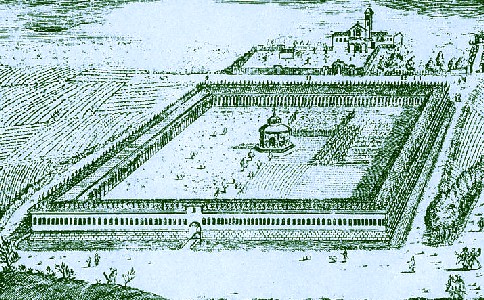
Artist: Marc'Antonia Dal Re - Il Lazzaretto Milano (1745)
Borrowing from the Venetian Republic's framework for quarantine, pratique and cordin sanitaire, Italians built a variety of lazarettos, some permanent, others temporary, to deal with the problem of the bubonic plague. While there were several maritime locations equipped to handle incoming ships, only two of them are mentioned in the sailor's accounts under study from around this period. These are Genoa, Livorno (often called Leghorn by the English) and Naples.
There were several other Italian lazarettos used in a maritime capacity during the golden age of piracy including at Santa Maria della Sanità at Milan (started in 1488, finished in 1513) Messina (the first permanent structure being built here in 1575), San Carlo in Trieste (started in 1720, finished around 1731), and Varignano in Spezia (1724). The Messina lazaretto should be somewhat familiar to readers by this point since the manual for its operation has been used extensively in previous sections. The Milan lazaretto isn't featured in previous descriptions nor does it appear in any sailor's accounts from around the period of interest. The other two lazarettos probably don't appear in the period sailing literature because they were built so late during the golden age or piracy (1690-1725).1 Because they are not discussed in the sailor's literature, these lazarettos will not be highlighted in this article.
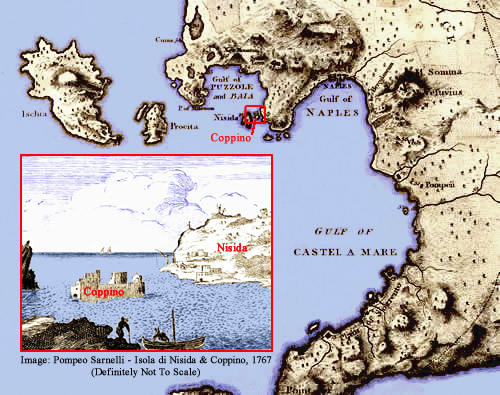
Cartographer: Sir William Hamilton - Map of Naples Islands, From Letters of Observations on Mount
Vesuvius, Mount Etna and Other Volcanos, (1772)
Of the three locations, Naples is mentioned twice by sailor Samuel Atkins in conjunction with quarantine and pratique, first in February of 1681 and then in May of the same year. However, he does not actually mention a lazaretto in either entry. During his February visit, Atkins explains that the local consul told them they were told not to expect to be given pratique, "they being more than usually strict upon the plague being in Spaine. Wee went in our boat to ye Mole side and sent off fresh provision."2 When Atkins ship HMS Crown stopped there in May, the local consul boarded their ship and, learning they were given pratique at Zante in March, they were granted pratique in Naples.3
Naples did have an active lazaretto before the golden age of piracy which was located on the volcanic island of Coppino or Chiuppino. It was built in 1628, already requiring restoration by 1656.4 (Naples suffered a plague outbreak from 1656-8 and it is not entirely clear that the lazaretto had even been restored at that point.) Whether it was still functioning by 1681 or not isn't clear. John Howard mentions the Naples lazaretto in passing, explaining that it "is very small, and I am informed that too little attention is paid there to passengers and shipping, under quarantine."5
1 For more information on these lazarettos, the reader is invited to check the following web pages: Lazzaretto di Milano, Lazzaretto at Messina, Fortezza de Varignano (Spezia) & Varignano Fortress Special Opening, and Là Dove le Navi Andavano in Quarantena (San Carlo lazaretto at Trieste); 2 Samuel Atkins, "A Sailor's Journal", Colburn's United Service Magazine, 1854, Part 1, p. 208; 3 Atkins, Part 1, p. 214; 4 Edourdo Nappi, Aspetti della societa e dell' economia napoletana durante la peste del 1656, 1980, p. 13-4; 5 John Howard, An Account of the Principal Lazarettos In Europe, 1791, p. 8
The Mediterranean Lazarettos - Italy: Genoa
The Genoa lazaretto was built on a plain at the the left bank of the mouth of the
Bisagno stream. The exact date of construction is not clear; one source puts the date at 14671,
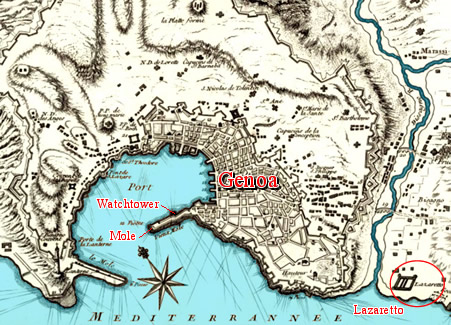
Cartographer: Georges-Louis Le Rouge - Genoa Map, Lazaretto Located in Red Circle (1742)
although historian and architectural professor Giovanni Assereto suggests that this was the year that it was decided to build a lazaretto, not the year it was actually built.2 Simona Olivieri says it "was completed in 1512 with the aim of accommodating the lepers, but was later transformed into a place of quarantine for goods and people from beyond the Domain."3Assereto states that this date is also inaccurate and that the actual foundation of the lazaretto "begins with
the the return of notary Ettore Vernazza in 1520 from
Rome"4. It was funded by Genoan Doge [Chief Magistrate] Ottaviano Fregoso with Vernazza selecting the location for the lazaretto in 1522. Asserto notes that the exact date the lazaretto began operation is unclear, but it was sometime before 1532 when records note that it was placed under the authority of the Magistrate of Health.5 Similar to other lazarettos established in the 16th centuries, the Genoan lazaretto was modified several times.
Asserto explains that the lazaretto originally served two functions: as a place to house the poor and, during plague outbreaks, as a hospital to house the ill.6 In this way, it would function in a manner similar to most land-based lazarettos, primarily used to quarantine people who
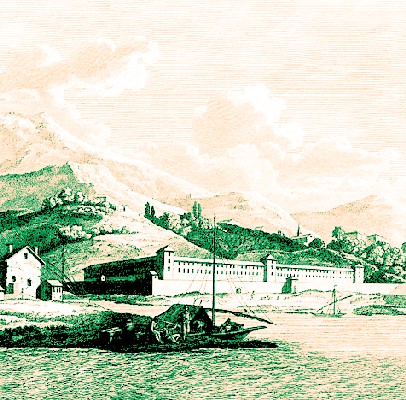
The Lazaretto at Genoa, Plate 2 From An Account of the Principal Lazarettos
in Europe., By John Howard (1789)
lived near it during times where the plague created an emergency. However, he goes on to explain that "it becomes a 'bulwark of health', an indispensable tool for the control of people and goods coming from the outside, until, in the mid-seventeenth century, that became its only reason for being."7 Olivieri points out that the lazaretto was used to quarantine ships as early as the sixteenth century. "On January 16, 1573, given the constant presence of the plague in the East, it was ordered that all the ships coming from that region were to be sent to the lazaretto, including ships that came from Naples, Messina and Sicily, because they often carried silks from the East. It was also established that while material was purging in the lazaretto no one could approach the goods without a permit."8 Like other Italian maritime lazarettos, Genoa quarantined both people and goods.
it is a mile from this building to the mountain and two miles across, there are beautiful and fruitful gardens cultivated with great diligence; due to which they produce every species and every variety of horticultural herbs and fruits in abundance. This territory is called the Bisagno plain... the beach is very suitable and comfortable to see the ships, but less than that of S. Pier d Arena; which is more rocky and sandy.9
Various art showing the lazaretto attest to the lushness of the surroundings.
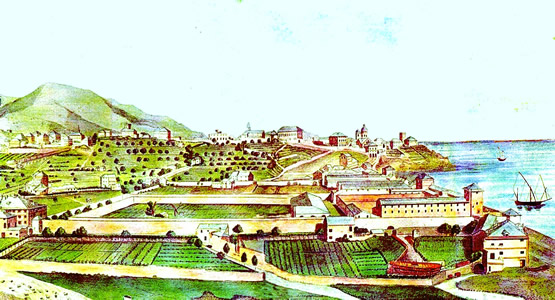
Artist: Domenico Del Pino - The Genoa Lazaretto and Surrounding Countryside (First Half of the 19th c)
The fact that Guistiniani points out that the location was well situated for spotting ships and giving them a suitable place to anchor suggests that the lazaretto was always intended to serve in some degree in a maritime capacity. Writing in the late 18th century, John Howard explained that the lazaretto was near to but still separate from the city, located close to the shore.10 This also verifies Guistiniani's comments about its suitability for incoming ships.
Of the lazaretto itself, Guistiniani simply says in 1537 that they built "a very large square building divided into two parts, with cloisters and many workshops for treating the sick with pestiferous illness"11. Fortunately, Howard gives a much more thorough description along with a floor plan. He calls the structure 'regular' with a center section splitting the structure in half, with each half being about three hundred and ten by twenty-five feet. His plan for the lazaretto (seen below) explains that the goods and individuals considered infected (foul) were put on one side of the lazaretto while those considered only suspect were placed on the other. Even the doors coming into the lazaretto kept the two different types of people entering from coming into contact with each other so as not to disturb their quarantines. The guard room at the entrance holds ten guards.
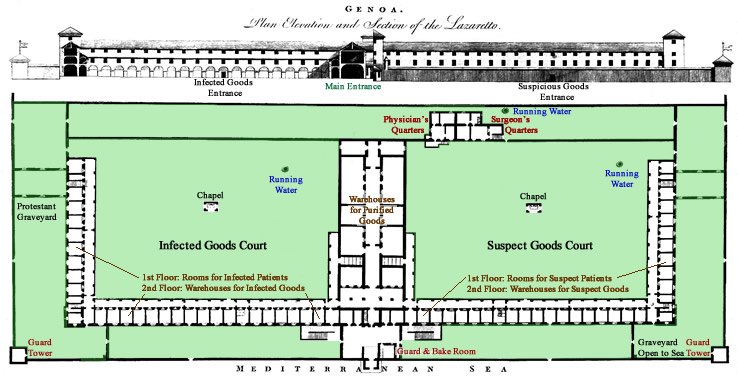 John Howard's Genoa Lazaretto Plan, Plate 2 From An Account of the Principal Lazarettos in Europe (1789) |
Howard says there are 36 rooms for passengers in the front of the building in addition to twelve which are for the use of the lazaretto's prior. He notes that one side (the right in the diagram) contains ten additional passenger rooms while the other contains eleven. The rooms are all similar, being sixteen foot,
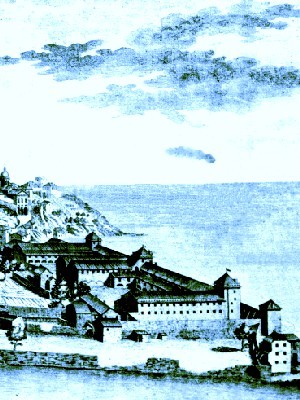
Artist: Antonio Giolfi
Genoa Lazaretto Interior (1769)
nine inches by fourteen feet, nine inches by eleven feet, six inches high. They have brick floors and vaulted ceilings with two windows which Howard opines are too small. These windows had bars and shutters, but no glass. There are doors in the corridor connecting the rooms which can be shut to allow for the creation of different sections of multiple rooms, so that all the passengers from a ship can serve their quarantine in proper isolation. A small chapel open on three sides was positioned in the center of each courtyard so that all those serving quarantine could hear mass. He also notes that there are three jail cells, "intended for riotous sailors who may be sent from the quarantine ships, and for the guards and porters, should they happen to be disorderly".12
The second story contains small sixteen-and-a-half foot wide warehouses, with two windows a piece which Howard again complains are too small. (This refers to the flow of air through the room. Since airing was felt to be the key to an good quarantine, effective air flow was of great interest to him.) The floors of the warehouses were stone, but Howard states that "such floors are improper; white bricks, well burnt, being best for goods, because less apt to become damp."13 He says that there are spacious, ten foot wide ascents leading to this floor which make good places to air bales of cotton. However, he complains that the doors to the warehouses are only single, being four feet wide and that folding doors would have been better.
Howard praises the water
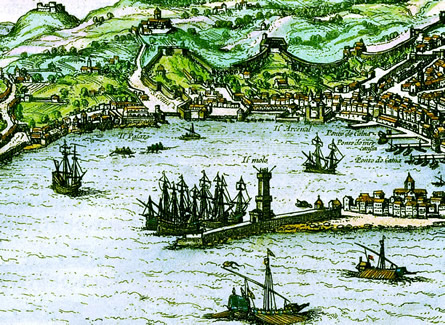
The Mole of Genova, Civitates Orbis Terrarum, By Georg Braun and Franz Hogenberg (1572)
supply, which he says is a "fine spring of water which comes from the mountains, and contributes much to its salutariness [healthiness]. [Note the several running water sources in the floor plan.] The Channel is full six feet wide at its entrance into the area, and this renders it very convenient for washing linen. Being also properly conducted through all the sewers, it prevents the rooms from being offensive."14
Future British navy official John Evelyn arrived in Genoa on a ship with a clean Bill of Health on October 16th, 1644 and, although he didn't have to serve quarantine, he does mention the quarantine procedure there as already discussed. The ship he was on anchored by the watchtower located on the mole or breakwater built in the Genoa harbor.15 The above image from a 1572 book clearly shows a large number of ships anchored at the tower on the mole built in the Genoa Harbor where Evelyn's ship was anchored. Sea surgeon James Yonge mentioned stopping at Genoa in the fall of 1664 while aboard the vessel Robert Bonaventure, and, needing a bill of health, he simply drew one up16. (See the section Quarantine at Mediterranean Lazarettos - Cheating.)
1 Proceedings and debates of the Third Annual Meeting of the Quarantine and Sanitary Convention, Baltimore, 1858, p. 259; 2 Giovanni Assereto, Per La Comune Salvezza dal Morbo Contagioso, 2007, p. 68; 3 Simona Olivieri, "La normativa della magistratura di Sanita di Genova (1500-1750)", La Berio, Jan-Jul, 1999, p. 9; 4 Assereto, p. 68; 5 Assereto, p. 69; 6 See Assereto, pp. 69-73; 7 Assereto, p. 73; 8 Olivieri, p. 10-1, citing legislation of the Magistrature of Health of Genoa; 9 Agostino Giustiniani, Annali della Repubblica di Genova, Vol. 1, 1854, p. 82, translated by the author; 10 John Howard, An Account of the Principal Lazarettos In Europe, 1791, p. 5; 11 Giustiniani, p. 82; 12,13,14 Howard, p. 6; 15 John Evelyn, The Diary of John Evelyn, Edited by William Bray, 1901, p. 83; 16 See James Yonge, The Journal of James Yonge [1647-1721] Plymouth Surgeon, 1965, p. 70
The Mediterranean Lazarettos - Italy: Livorno
The city of Livorno is unique among the Italian port cities which had maritime lazarettos in that it
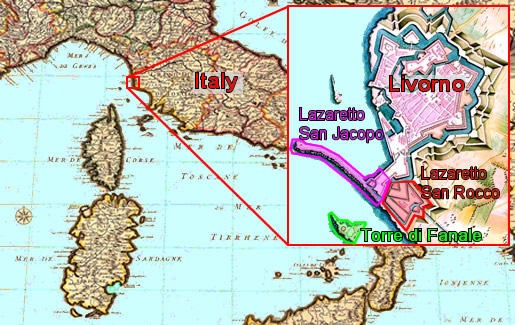
Map of the Three Livorno Lazarettos In Use Before and During the Golden Age of Piracy,
Large map: Northern Italy,
by Alexis Hubert Jaillot (1708);
Small Map: Livorno (18th c.), By Unknown
was specifically designed to handle shipping traffic. "The urban history of Livorno is, in fact, linked to the construction of defensive structures, the "invention" of a port, the birth of a city and its' projection into Mediterranean trade."1 Historian Michela D'Angelo explains that what was once 'a poor village' was deliberately designed to be a center of commerce. The Grand Duke of Tuscany, Cosimo I of Medici saw the potential for Livorno as a commercial center, building infrastructure which would allow the city to be a military and commercial center in the 16th century which included renovating the fortress, creating navigable channels between Livorno and nearby Pisa, tax exemptions and incentives which would encourage foreign investment, the establishment of warehouses to provide free storage and the services and facilities necessary to promote commerce.2
Photo: Lucas Aless - Torre del Fanale Lighthouse As It Appears Today
Among the facilities built to modernize the village were warehouses and a lazaretto which were placed at the base of the lighthouse Torre de Fanale or Fanale dei Pisani, which were completed in 1584 under Grand Duke Francesco I de Medicini, Cosimo I's son. Little is known about the lazaretto built here because it was deemed inadequate for its purpose (possibly because it was so small) and was quickly replaced by a new lazaretto which began construction in 1590. Historian and priest Giuseppe Piombanti suggests that the structure was not only inadequate for its purpose, it proved to be a "shabby lazaretto built around the base of the lighthouse, thus disfiguring that magnificent tower."3 However, its impact on the appearance of the lighthouse probably had little to do with the construction of the new lazaretto. Its size seems to have been the real problem; even Piombanti mentions that its successor was built "in order to spare them from having to serve quarantine at the nearby islands"4, at least suggesting that what was there was not sufficient for the demand.
When Francisco's brother, Fernando I de Medicini, succeeded him upon his death in 1587, he decided to transform Livorno into a fortified city. Since the lazaretto at the base of Torre de Fanale was deemed insufficient, he built a new lazaretto called Lazzeretto di San Rocco (Lazaretto of St. Roch) in 1590.5 Of this lazaretto, Piombanti says it was "a large and beautiful lazzeretto, which took its name from St. Roch, a victim of his zeal in helping the plague victims"6.

Warehouses in Lazaretto San Rocco (1860)
(St. Roch may or may not have died from the plague. He was, however, often recognized as a patron saint of plague victims, being called upon to heal them beginning in the early 15th century.7) Piombanti also notes that this lazaretto was 'greatly enhanced' in the seventeenth century, but does not provide specific details of what was done. Lazaretto San Rocco was still in operation during the golden age of piracy, unlike its predecessor.
A diagram of the lazaretto as it appears in 1860 (seen at left) provides the names of the various warehouses, providing some indication of the order in which they were built, although the exact dates are unknown. An earlier image of the plan of the lazaretto shows it with only the two V-shaped buildings - the Lantern Warehouse and the Parlours - so they were built first. The name of one being 'Lantern' also hints that this warehouse was built to replace the original lazaretto warehouses built at Torre di Fanale lighthouse. The date of the addition of the Olive Tree and New Warehouses is unknown, although they both appear in a diagram from 1630 found in the Istituto Storico e di Cultura dell'Arma del Genio militare.8 In his doctoral thesis, Joaquim Tolós explains that the Leather Purging Warehouse was a later addition.9 (The Leather Purging Warehouse does not appear in plan included in the 1783 book Raccolta delle piu belle vedute by Guiseppe Maria Terreni. So it would not have been there during the golden age of piracy.) Recall that people found the smell of the drying leather offensive which is the most likely reason this warehouse was located on its own island so far from the other buildings. The location of the rooms used to house those chosing to serve their quarantine on land is not clear from this diagram, although Tolós states that there was "a small island for quarantines [people performing quarantine] that were totally isolated from the goods."10 This almost certainly refers to the little island above the 'V' where the warehouses and parlours were.
Piombanti describes the Lazaretto of St. Roch in some detail.
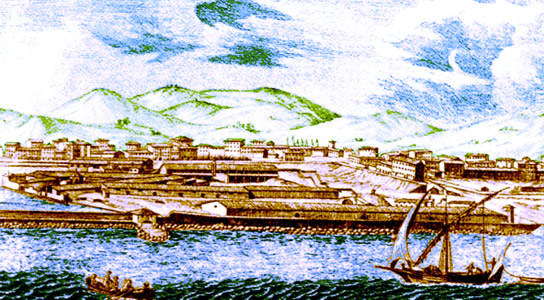
Lazaretto San Rocco, From Raccolta delle Piu Belle Vedute della Ditta e Del Port di Livorno Con Alcune
Osservazioni Storiche Sopra le Medesime, By Giuseppe Maria Terreni (1797)
It was intersected by ditches, which dried the marshy place; equipped with stairs, squares, vast and multiple warehouses, and storehouses for the safekeeping and isolation of suspicious goods; with separate houses for passengers, transport and a cemetery; with an internal chapel, isolated and wrapped in glass, so that people could attend religious services from a distance; with well-distributed galleries so that relatives or friends could talk to those serving quarantine; with wells, a restaurant and doctors. Two senior clerks presided over it with the titles of captain and lieutenant, and a good number of guards supervised the exact observance of the strict regulations. It was separated from the city with a canal, and people entered it using a drawbridge, in front of which stood the chapel, dedicated to St. Roch11
An interesting facet of the lazaretto of San Rocco at Livorno is how much space is devoted to the facility, something that can be appreciated in the above image. Unlike the other lazarettos discussed thus far, San Rocco created different 'islands' for different purposes by digging canals to separate them. Because the city was 'designed' to facilitate commerce, it was possible to replace the inadequate lazaretto warehouses at the base of the Torre di Fanale lighthouse with a facility placed on the outskirts of the city, but still within the city fortification that was designed to accommodate commercial shipments.
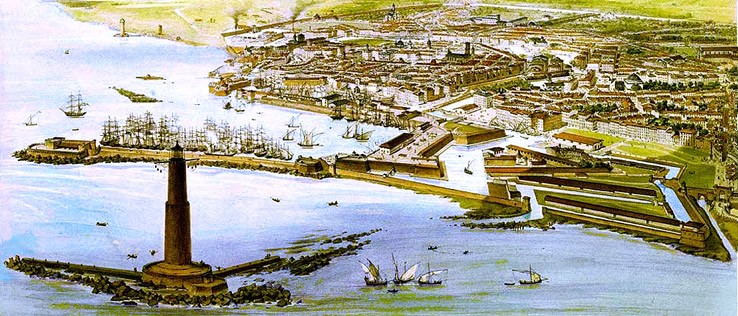 Artist: Alfred Guesdon - View of the Three Lazaretto Locations in Livorno (1850) In the Foreground is Torre di Fanale, Left Middle is Lazaretto San Jacopo, Right MIddle is Lazaretto San Rocco, In the Back is City of Livorno. Note that by the date of this image, the San Jacopo Lazaretto had been expanded and transformed into a prison and military barracks. |
As large as the San Rocco lazaretto was, it was still insufficient for the amount of sea traffic at the port.12 Trade with eastern Turkish countries caused increasing problems with the plague during the seventeenth century. Ships started diverting to quarantine at the island of Portoferraio, which "was very detrimental to commerce and to the merchants of the city... the government told Ferdinand II that if he did not order the erection of a nearby lazaretto, the ships would start going to Genoa or Marseille, taking with them a huge part of our traffic"13. As a result, Grand Duke Ferdinand II of Medici decreed that another lazaretto was to be built on May 22, 1643. Between 1643 and 1648 the San Jacopo lazaretto was constructed two kilometers south of the city. Like its predecessor, additions were made to San Jacopo after its construction. It was enlarged by Grand Duke Cosimo II of Medici in 1721.
Tolós gives a brief description of the first parts of the lazaretto:
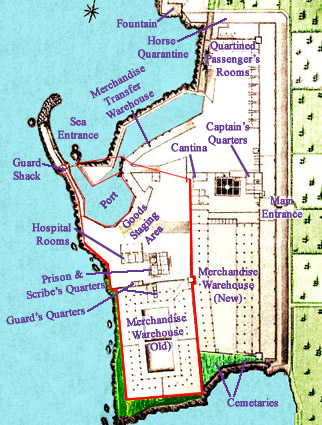
Lazaretto San Jacopo Plan, (Mid 18th c)
The enclosure was originally formed by sheds and a surrounding wall that included, on the one hand, a building that was already in place which served to hold passengers who defied the law and, on the other, a large rectangle with a central patio. This patio, covered by a roof around the perimeter, was used to store the goods and had, as a port, a small natural cove.14
The location of the original lazaretto is seen outlined in red in the image at right. Although the date(s) of the additions to the lazaretto are unknown, it is quite likely that those appearing in this plan outside the red area occurred during the 1721 enlargement of the facility given that this diagram is believed to have been drawn some time between 1730-1750.
The lazaretto was surrounded by a dry moat and a tall wall. It was accessed from land using drawbridge at the main entrance. Although not visible in this image because of the lettering, there were two guard shacks on either side of the moat. Several guard towers (seen as small squares on the outside walls of the expanded facility and one in the old facility wall) were also present.
There were also vast sheds for the storage of quarantined goods, a circular chapel and an enclosure for animals. In this area, near the warehouses, the marble statue of the Grand Duke Pietro Leopoldo was erected, dressed as a Roman centurion and placed in a rich marble niche. This was eventually transferred, on Vigo's proposal, to the square in the churchyard of San Jacopo, where still stands. The other section, further south [the 'old' warehouse'], was called 'La Gabbia' ['The Cage'] and was in turn isolated from an internal ditch by the rest of the complex; here the sick and the infected goods were segregated.15
This lazaretto was built specifically for the quarantine of people and merchandise coming into Livorno with either suspect or foul bills of health. Lazaretto
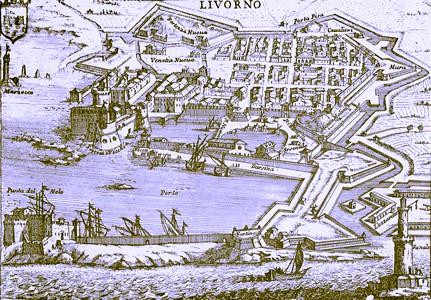
Map of Livorno Showing All Three Lazaretto Sites (1761)
San Rocco was then used for the brief quarantines of those coming in with a clean bill of health. Lazaretto San Jacopo was used until 1846, after which it was transformed into a prison and military barracks. It was eventually incorporated into the Italian Naval Academy.
John Howard had high praise for the Livorno lazaretto (which he called by the British name 'Leghorn'). "The greatest attention is given both to the health and convenience of the passengers, and the merchandise is kept in the exacte order. ...Our ambassador at Constantinople, Sir Robert Ainslie told me, that the lazarettos at Leghorn are the best in Europe. This was confirmed to me by two gentlemen who had performed quarantine both there, and at Marseilles."16
The Livorno lazarettos did indeed have a place in the British heart; they appear in three different sailors' accounts from around the golden age of piracy. According to historian Katerina Galani, "The operation in Livorno was extremely important to the British and was one of the reasons as to why they were attracted in large numbers to this particular port. Livorno, compared to other quarantine stations in the Mediterranean, was meticulous in the sanitary services offered. This was manifested in the long duration of quarantine at the port, which made the Livornese bill of health a trustworthy pass."17 Historian Carlo Cippoli points out that other locations with large lazarettos sometimes presented political problems for England. "Marseilles was part of the Kingdom of France with which the English were often in conflict; Naples was part of the Spanish Empire and England and Spain were often at loggerheads; Genoa was an independent republic but linked to Spain with a double thread. None of these ports could become the permanent base of English commerce as Livorno did."18
The quarantine periods used at Livorno were forty days for ships with foul bills of health, thirty-five days for those with suspect bills and 20 days for clean bills of health.19 The British began using
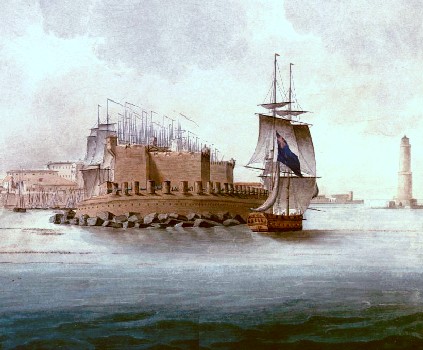
View of the Isthmus Off Lazaretto San Jacopo & Torre di Fanale (1790-1800)
Livorno in the late sixteenth century when the Levant Company was chartered, establishing a small shipping warehouse (called a factory) there, which gradually expanded over time.20
Of the three sailors who discuss the Livorno lazaretto, two of them only mention it in passing. Chaplain Henry Teonge noted that when HMS Assistance arrived at Livorno on August 13, 1676 they were not likely to receive pratique at the port, "yet they tell us that to-morrow we shall have provisions off."21 Apparently a supply of provisions was sufficient because they did not stay to quarantine the ship. In the same year, Edward Barlow reported that HMS Monke stayed at Livorno "a little while for pratique, [after which] our boat went ashore and carried our passengers ashore, who were glad they were arrived at their desired port"22. He does not give any other details, so nothing of the lazaretto can be gleaned.
The last sailor to mention the Livorno quarantine process is Samuel Atkins, who was first there in February, 1681 aboard HMS Crown. On the fourteenth, he reported that he and a Mr. Leighton "went to ye Boca [mouth, probably the entry way to the port] last night, and spoke with ye English merchants, and also gave account of ye number of our ships, whence wee came, and whither bound, in order to ye getting prattick [pratique]."23 On the 18th, Atkins dined aboard a merchant ship where the sailors complained about the difficulty of obtaining pratique, which caused him to complain about the quarantine at some length in his journal. (See the section Quarantine at Mediterranean Lazarettos - Cheating.) HMS Crown was once again at Livorno a year later; the officials there sent a doctor aboard who asked 'a few impertinent questions' and then granted them pratique.24
1 Michela D'Angelo, "Livorno 1421-1606 da Villaggio a Citta-porte Mediterranea", VI congresso AISU - VisibileInvisibile: percepire la città tra descrizioni e omissioni, p. 1, translated by the author; 2 D'Angelo, p. 3-5; 3 Giuseppe Piombanti, Guida Storica ed Artistica della Città e Dei Dintorni di Livorno, 1903, p. 336, translated by the author; 4 Piombanti, p.26; 5 Antonia Teoli, “Il Lazzaretti di Livorno”, A Livorno per caso, gathered 5/14/19, translated by the author; 6 Piombanti, p. 336; 7 Gregory Cleary, "St. Roch", The Catholic Encyclopedia, 1912, Retrieved from www.newadvent.org on 5/18/19; 8 Joaquim Bonastra Tolós, "Appendix I: Figura II.16 Veduta di Livorno avanti fosse accresciuto con nuove fortificazioni, siglo XVII (ISCAG, cart. XXII nº 1630)", Ciencia, Sociedad y Planificación Territorial En La Institución Del Lazareto, Doctoral Thesis, University of Barcelona, 2006, not paginated; 9,10 Tolós, p 257; 11 Piombanti, p. 336; 12 Tolós, p. 258; 13 Teoli, gathered 5/14/19; 14 Tolós, p. 258; 15 Maurizio Silvestri, "I lazzeretti di San Jacopo e San Leopoldo", Livorno Magazine, livornomagazine.it, gathered 5/14/19, translated by the author; 16 John Howard, An account of the principal Lazarettos in Europe, 1789, p. 7; 17 Katerina Galani, British Shipping in the Mediterranean during the Napoleonic Wars, 2017, p. 100; 18 Carlo M Cipolla, Il burocarte e il marinaio, 1992, p, 14, translated by the author 19 Galani, p. 101; 20 Galani, p. 97; 21 Henry Teonge, The Diary of Henry Teonge, Chaplain on Board H.M.’s Ships Assistance, Bristol, and Royal Oak, 1675-1679, 1825, p. 199; 22 Edward Barlow, Barlow’s Journal of his Life at Sea in King’s Ships, East and West Indiamen & Other Merchantman From 1659 to 1703, p. 274; 23 Samuel Atkins, "A Sailor's Journal", Colburn's United Service Magazine, Part 1, 1854, p. 206; 24 Atkins, Part 2, p. 544

